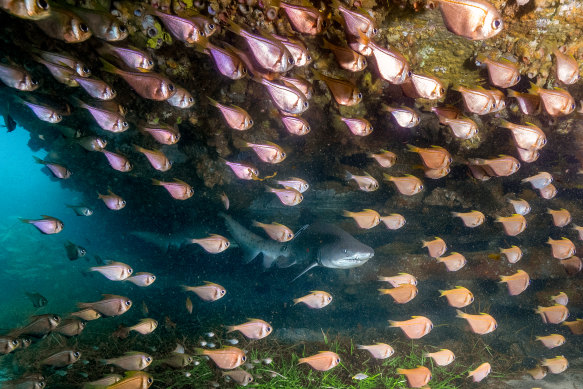
About 100 metres off the point between Tamarama and Bondi Beach, beneath a light cloud of tawny-coloured jelly-blubbers and a thick shoal of yellowtail scad, two grey nurse sharks sheltered under a rock overhang on Saturday morning.
They were oblivious to the free-divers struggling to hold their breath long enough to take clear photos of them 10 metres beneath the swell.

Two young grey nurse sharks amid a school of fish 10 metres underwater off the headland at South Bondi on Saturday.Credit:Duncan Heuer & Edwina Pickles
The sharks were young, both smaller than two metres long, and presented no threat despite the fierce-looking teeth that once led them to be killed on sight.
So many were killed, and their breeding cycle so slow, that the timid creatures are now critically endangered in NSW.
Although protected by law, grey nurse sharks are still injured internally by fishing hooks and drowned in nets such as the one that kills so many large sea animals each year a few hundred metres away, at Bondi Beach.
The Bondi net was first designed to kill sharks rather than just keep them away from swimmers.
Little is known about the animal, which is why recreational and commercial divers were counting its numbers up and down Australia’s east coast on Saturday. The first co-ordinated census of the grey nurse targeted known “aggregation sites”, from Wolf Rock in south Queensland to Montague Island in south NSW.
Leading the Bondi expedition was Duncan Heuer, who is part of a group behind the Saving Norman website, which is campaigning for the removal of the Bondi shark net, a project now backed by Waverley Council. (Local ocean swimmers often affectionately refer to any shark they see in the area as Norman.)
Heuer points out that the net – which extends just 150 metres along Bondi’s 800 metres, reaching neither the surface nor the seafloor – was first designed to kill sharks rather than just keep them away from swimmers.









 Add Category
Add Category